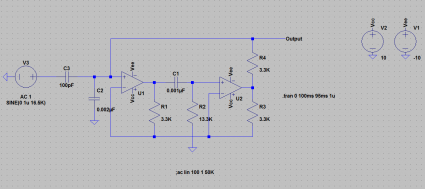While watching TV (not very closely) I went ahead and entered the “gyrator” part of the Gyrator VLF circuit. It does indeed seem to work. No real analysis, just the circuit as I built it.
Daily Archives: 6/15/2011
The Gyrator VLF receiver…
Back on June 7, there was a spectacular coronal mass ejection on the sun:
Yes, I did mention this event and gave some links to VLF receivers at the time, but I’ve been thinking about this some more.
As an astronomy/telescope buff, I have built simple telescopes for looking at the sun, but I haven’t done much of that lately, and I have only recently become interested in observing the sun’s effect on the Earth’s radio environment. I’ve also had a fairly longstanding interest in VLF communications, and so the prospect of building a radio system for monitoring radio for SIDs (Sudden Ionospheric Disturbances) seems like a good project. I recall that Mark Spencer, WA8SME whom I’ve had the pleasure of meeting at Pacificon and even chatted with via the AO-51 satellite had published some articles on designing such radios for amateur and educational construction.
The most common way to monitor for SIDs is to try to detect the signal strength of the VLF station in Cutler, ME on 24Khz. Changes in signal strength can indicate the presence of solar flare activity as the ionosphere is bombarded by high energy particles. One common circuit that lots of people use is called The Gyrator VLF circuit, which you can find here:
The Original Gyrator Circuit (PDF)
I had never really looked at this circuit very carefully before, and looking at it tonight, I realized that it was actually fairly interesting and employs a technique which I hadn’t seen before. Instead of making a tuned front end using a (fairly large, because of the low frequency) inductor, they create an equivalent circuit using two op amps and a collection of resistors. This creates an inductor with very high Q, with the side effect that is easier to make, using operational amplifiers that you can still get at Radio Shack. I’ll probably try to simulate some of the basics with LTSpice to gain some intuition as to what’s going on, but it’s a simple enough circuit that just building it would be pretty easy.
The basic circuit has undergone a couple of iterations, and now the Gyrator III schematic is recommended by the AAVSO. You can check out the details here (and surf around, the AAVSO has lots of information on this stuff).
Software Defined Radio Links
I own an SDR-IQ software defined radio, a Funcube Dongle (more on that later) and have built a marginally operable Softrock Lite receiver, so you might say I’m interested in Software Defined Radios. But Jeri’s tinkering with her own software defined radio has rekindled my interest in homebrewing one. I was looking for Gerald Youngblood’s (AC50G) QEX article series entitled “A Software Defined Radio for the Masses”) and found that one good place to find it (and many other interesting articles) was unsurprisingly on the ARRL’s website.
Jeri also pointed me at a an awesome presentation by Dan Tayloe, N7VE entitled “Very High Performance Image Rejecting Direct Conversion Receivers” that has lots of information that go well beyond my current understanding of receiver design and performance. Good reading, which will hopefully turn into a good project.
A Cree LED in my linear current LED Transmitter
I was away all weekend, so I didn’t get a chance to check out my LEDs that I got from Deal Extreme last week. Tonight, I just soldered a couple of clip leads and tried it out when hooked to the linear current modulator that I built (and blogged about) before. The transmitter in this video is set to pull an average of about 10ma average through the diode, with a peak of 20ma. That’s hardly enough to really get the cree going at all (I believe this one can go all the way to 350ma or so, and about 1W of output power) but it was enough to play with.
After I filmed this, I changed the current limiting resistor from 100 ohms to 16 ohms (by ganging two 32 ohm resistors together) and wired my multimeter in series with the supply to measure the power, and as expected it was 60ma, for an output of around 150mw or so (I didn’t measure the voltage drop, but I think it’s around 2.6 volts). It was quite a bit brighter, and was detectable even without any optical assistance at the other side of my room. To go much higher, I think I should probably swap the 2N3904 that I’m using to modulate it with something a bit beefier (like the IRF510s that I have lying around) and I’ll need some 1/2 watt current limiting resistors (probably around 3 ohms).
I’ll play with this some more in the next few weeks.
